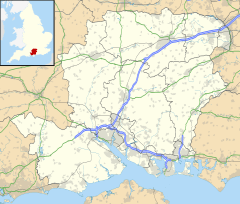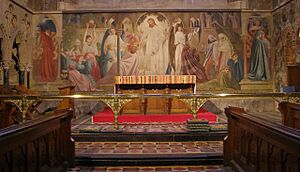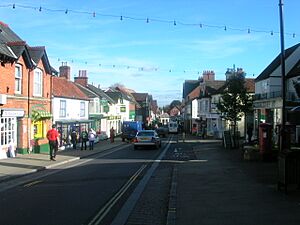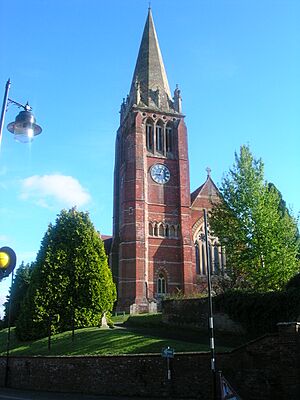Lyndhurst, Hampshire facts for kids
Quick facts for kids Lyndhurst |
|
|---|---|
 Lyndhurst High Street, February 2020 |
|
| Population | 2,973 (2001 UK census) 3,029 (2011 Census) |
| District |
|
| Shire county | |
| Region | |
| Country | England |
| Sovereign state | United Kingdom |
| Post town | Lyndhurst |
| Postcode district | SO40, SO43 |
| Dialling code | 023 |
| Police | Hampshire |
| Fire | Hampshire |
| Ambulance | South Central |
| EU Parliament | South East England |
| UK Parliament |
|
Lyndhurst is a large village located in the beautiful New Forest National Park in Hampshire, England. It's about nine miles (14 km) southwest of Southampton. Many people call Lyndhurst the "Capital of the New Forest" because it's where the New Forest District Council and the special Court of Verderers are located.
Lyndhurst is a popular spot for tourists. It has many unique shops, art galleries, cafes, museums, pubs, and hotels. In 2011, about 3,029 people lived there. The name Lyndhurst comes from an old English name meaning 'wooded hill with lime trees'. The village was first mentioned in the Domesday Book in 1086.
The church of St. Michael and All Angels was built in the 1860s. It has a beautiful fresco by Lord Leighton and amazing stained-glass windows by famous artists like William Morris and Edward Burne-Jones. Alice Liddell, who inspired the character Alice in Lewis Carroll's Alice's Adventures in Wonderland, is buried there.
Contents
A Look at Lyndhurst's Past
The name "Lyndhurst" comes from old English words: lind (meaning 'lime-tree') and hyrst (meaning 'wooded hill'). This tells us what the area was like a long time ago! Lyndhurst was first written about in the Domesday Book of 1086, which was a big survey ordered by William the Conqueror. Back then, it was called 'Linhest'.
Lyndhurst was part of the royal lands of the New Forest. This meant it belonged to the King or Queen. For many centuries, the manor (or estate) of Lyndhurst was often given to different royal family members or important noble families. It was even part of the dowry (money or property brought by a bride to her husband) for four queens of England!
The King's Park was a special area near the manor of Lyndhurst. It was unusual because it was a King's Park inside a King's Forest. In 1299, it was about 500 acres (200 hectares) in size. Today, the Lime Wood Hotel stands where the "old Park" of Lyndhurst used to be.
Exploring Lyndhurst's Location and Landmarks
Lyndhurst is right in the middle of the New Forest National Park in Hampshire, England. It's considered the main town for the New Forest because the district council is based here. The special Verderers' Court, which helps manage the New Forest, also meets in the King's House in Lyndhurst. Even the local office for the Forestry Commission, which looks after the forest's trees and paths, is in the King's House.
The church of St. Michael and All Angels is a big landmark in the village. It's built with different colored bricks and has a very tall spire that you can even see from the Isle of Wight!
Glasshayes House, also known as the Lyndhurst Park Hotel, is an old Georgian building. After some changes in 1912, it became the only building left that was designed by the famous writer Sir Arthur Conan Doyle (who wrote the Sherlock Holmes stories!). Local stories say it's haunted by a ghost!
Right next to Glasshayes House is Bolton's Bench, a pretty hill. Local folklore says this hill was once the body of a dragon! Other famous spots include cute thatched cottages on the way to the nearby village of Emery Down. The New Forest Centre is also here, which has a museum and gallery where you can learn all about the New Forest.
Near the edge of the village is Foxlease, a training center for Girlguiding UK. It has hosted many important Girl Guiding events from around the world.
The King's House: A Royal Connection
The most important building in Lyndhurst is the King's House. It's sometimes called the Queen's House, depending on whether a King or Queen is on the throne! It's the main building owned by the Crown in the New Forest. Inside, you'll find the Verderers' Hall, which is where the ancient Verderers' Court meets. The King's House is also the local office for the Forestry Commission.
A royal manor house probably existed in Lyndhurst as early as the 1200s. Kings and Queens often visited this hunting lodge. Over the centuries, the house was repaired and made bigger many times. The building you see today mostly dates from the 1600s. The last monarch to stay here was King George III in 1789.
Today, the King's House is a large, two-story brick building. Inside the hall, you can still see the old prisoners' dock, tables, and chairs. There's also a famous "Stirrup of Rufus" which was used to measure dogs!
Places of Worship
The main Anglican church in the village is St Michael and All Angels. It sits on a small hill overlooking Lyndhurst. It was built between 1858 and 1870 and is made of red brick with yellow details. Its tall spire, reaching 160 feet (48.8 meters), can be seen from far away.
Inside, the church has exposed brickwork in yellow, white, and red. The ceiling of the main part of the church is decorated with life-sized angels. There's a famous fresco painting by Frederick Leighton called the Parable of the Wise and Foolish Virgins. It's said that the people in the painting were modeled after local villagers! The church also has beautiful stained glass windows designed by famous artists like William Morris and Edward Burne-Jones.
Alice Liddell, who was the inspiration for Alice in Lewis Carroll's Alice's Adventures in Wonderland, lived near Lyndhurst after she got married. She is buried in the churchyard here.
Lyndhurst also has a lovely, small Catholic Church called the Assumption and St Edward the Confessor. It was built between 1894 and 1896. There is also a Baptist church in the village.
Learning and Culture
Saint Michael and All Angels Infant School is the main school for young children in the village. Lyndhurst Pre-School is right next to it. For older children, the New Forest Small School is an independent school for ages 3 to 16.
The Legend of the Bisterne Dragon
Lyndhurst is famous in English folklore for a story about a dragon-slaying! The local legend says that a dragon lived in a den at Burley Beacon, near Burley. One version of the story says the dragon would fly every morning to Bisterne to get milk.
To defeat the dragon, a brave knight (often called Berkeley) hid and waited with two dogs. When the dragon came for its milk, the dogs attacked it. While the dragon was busy with the dogs, the knight surprised it. The fight was fierce, and the dogs died in the battle. The fight continued all through the forest, and the dragon finally died outside Lyndhurst. Its body supposedly turned into a big hill, which is now known as Bolton's Bench.
Even though the knight won, the battle had changed him. After 30 days and nights, he returned to Bolton's Bench to die alone on top of it. His body then turned into the yew tree that you can still see there today!
Getting Around: Transport Links
Lyndhurst is a meeting point for two main roads: the A35, which goes between Southampton and Bournemouth, and the A337, which goes between Cadnam (on the M27) and Lymington. Because so many cars pass through the village, Lyndhurst has a one-way system to help manage traffic. This basically turns the main roads into a big roundabout.
For a long time, people have talked about building a bypass road around Lyndhurst to ease traffic. However, building a road through the New Forest National Park is very difficult because it's a protected area. Public meetings have been held, but so far, no bypass has been built because of concerns about harming the environment.
Lyndhurst doesn't have its own train station, but it's close to several. Ashurst New Forest railway station is about three miles (5 km) away and was once called Lyndhurst Road station. Brockenhurst station is also only four miles (6.4 km) away. These stations are on the main train line to London and Weymouth. Bus services run often to Southampton and Lymington. You can also catch a National Express coach to London Victoria from Lyndhurst. In the summer, the New Forest Tour, an open-top bus, starts and finishes in Lyndhurst.
Famous People from Lyndhurst
- Arthur Phillip
- Alice Liddell
- Keith Harris
- Nigel Eaton, a hurdy-gurdy player
Twin Towns
Lyndhurst is twinned with:
Images for kids
-
Christ Church, Emery Down, a Grade 2 listed building from 1864
-
Thatched cottages at Swan Green
-
The grave of Alice Liddell in Lyndhurst
See also
 In Spanish: Lyndhurst para niños
In Spanish: Lyndhurst para niños










